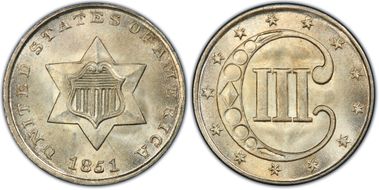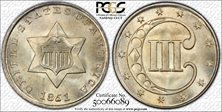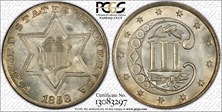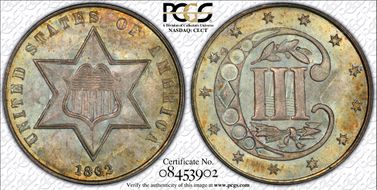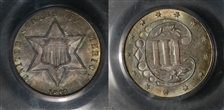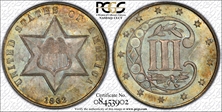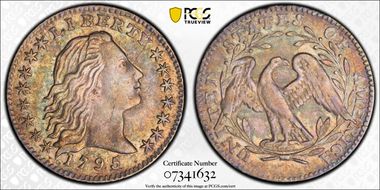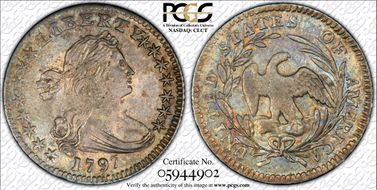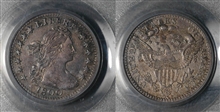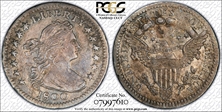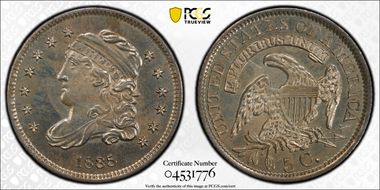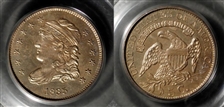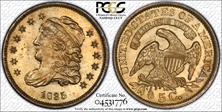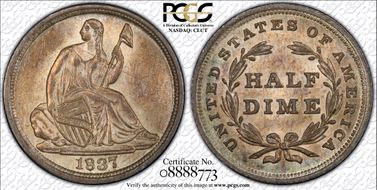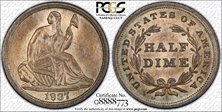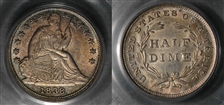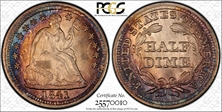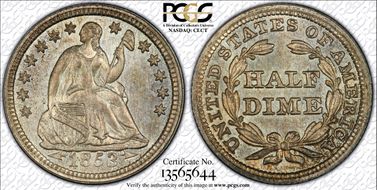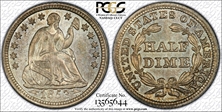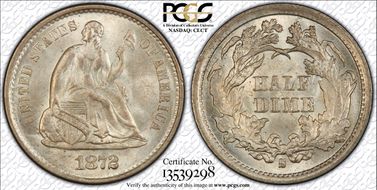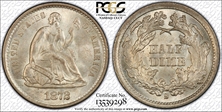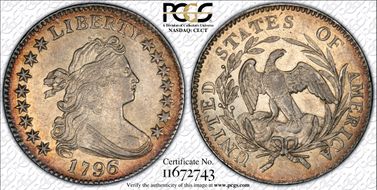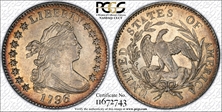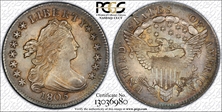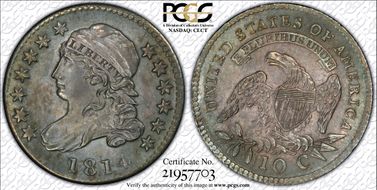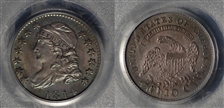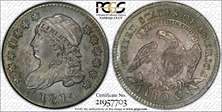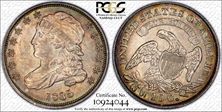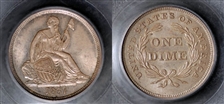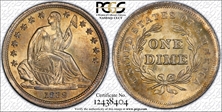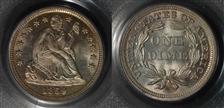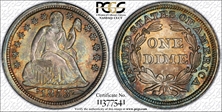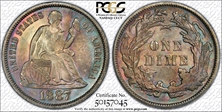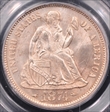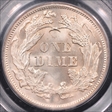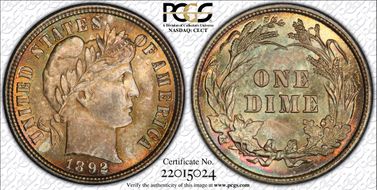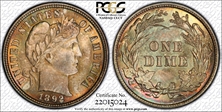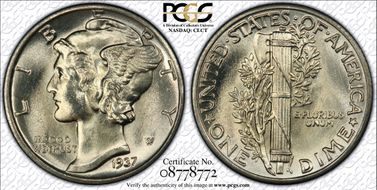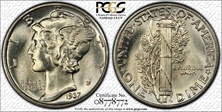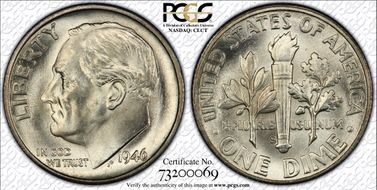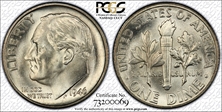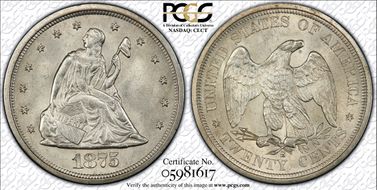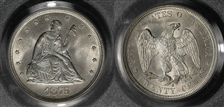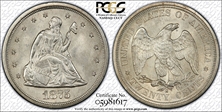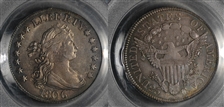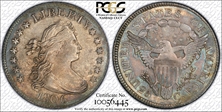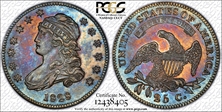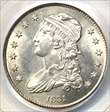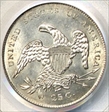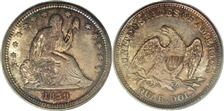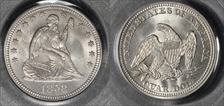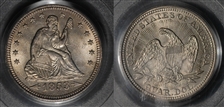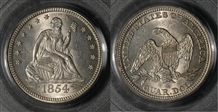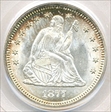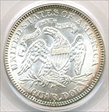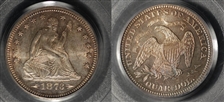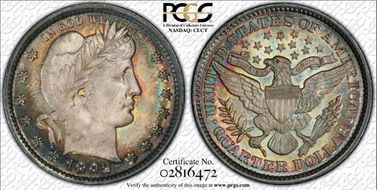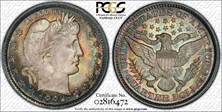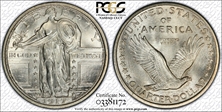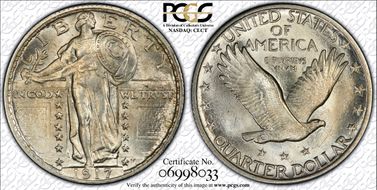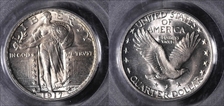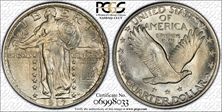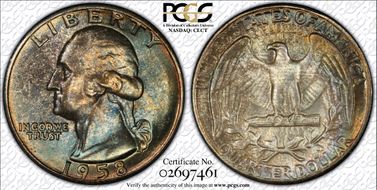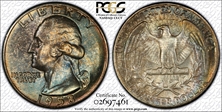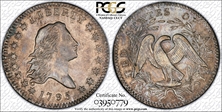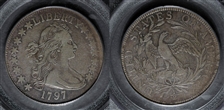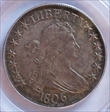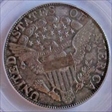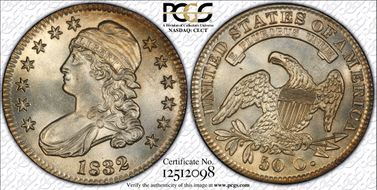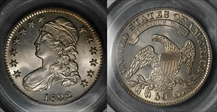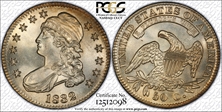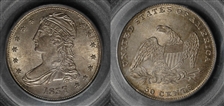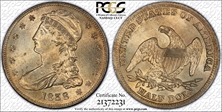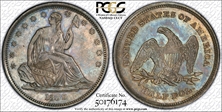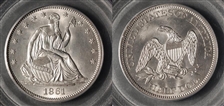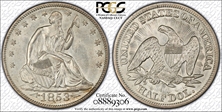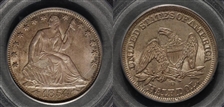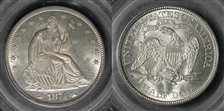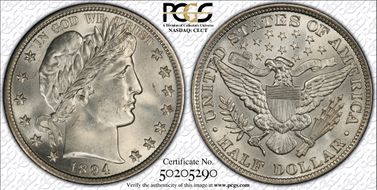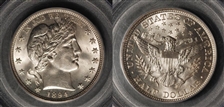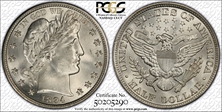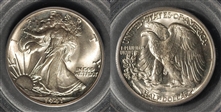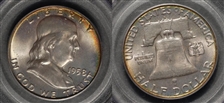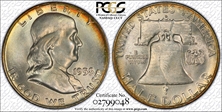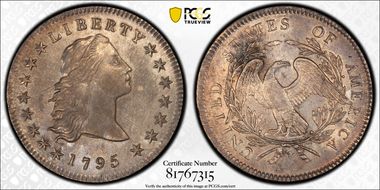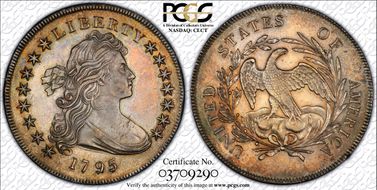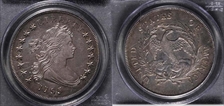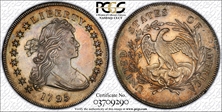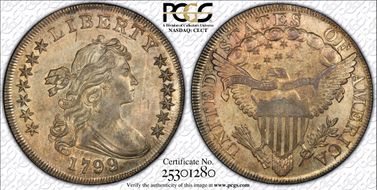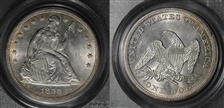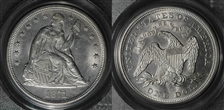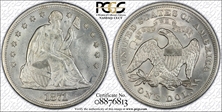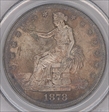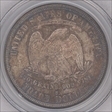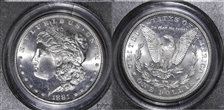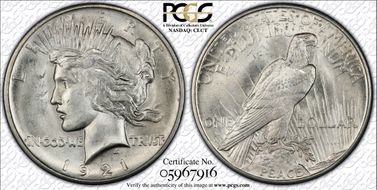Golbrecht's Raisinet Collection 的钱币相册
The strike is uncommonly sharp, since the shield is fully brought up, and the stars have crisp centers. Booming luster and gentle tan-gray toning provide further eye appeal. Only a wispy diagonal mark above the 51 in the date denies perfection.
The strike is uncommonly sharp, since the shield is fully brought up, and the stars have crisp centers. Booming luster and gentle tan-gray toning provide further eye appeal. Only a wispy diagonal mark above the 51 in the date denies perfection.
Light yellow toning surrounds the silver-gray centers of this satiny and choice near-gem. A clash mark from the C is visible at the top of the obverse. The surfaces are remarkably clean for the grade, and there is great eye appeal.
Light yellow toning surrounds the silver-gray centers of this satiny and choice near-gem. A clash mark from the C is visible at the top of the obverse. The surfaces are remarkably clean for the grade, and there is great eye appeal.
1862/1 3CS MS66. The left half of the 2 in the date has a faint but nearly complete 1. The underdigit is faint but clearly discernible with a magnifier. Bold die clash marks are evident on this scarce overdate variety, especially on most of the obverse shield within the III. Very sharply struck for a Type Three, this piece shows exceptionally pronounced evidence of die clashing, and that is saying a lot for a three cent silver as they are usually die clashed.
1862/1 3CS MS66. The left half of the 2 in the date has a faint but nearly complete 1. The underdigit is faint but clearly discernible with a magnifier. Bold die clash marks are evident on this scarce overdate variety, especially on most of the obverse shield within the III. Very sharply struck for a Type Three, this piece shows exceptionally pronounced evidence of die clashing, and that is saying a lot for a three cent silver as they are usually die clashed.
1862/1 3CS MS66. The left half of the 2 in the date has a faint but nearly complete 1. The underdigit is faint but clearly discernible with a magnifier. Bold die clash marks are evident on this scarce overdate variety, especially on most of the obverse shield within the III. Very sharply struck for a Type Three, this piece shows exceptionally pronounced evidence of die clashing, and that is saying a lot for a three cent silver as they are usually die clashed.
Lots of detail for VF25, Old Green Holder, R.4 PQ A large question surrounding this coin is whether or not President Washington supplied the silver. Research by Joel Orosz and Carl Herkowitz published in the 2003 Amer. Journal of Numismatics cited a memorandum by John A. McAllister, Jr. who related his interview with Chief Coiner Adam Eckfeldt: "In conversation with Mr. Adam Eckfeldt (Apr. 9, 1844) at the Mint, he informed me that the Half Dismes...were struck, expressly for Gen. Washington, to the extent of One Hundred Dollars, which sum he deposited in Bullion or Coin, for the purpose. Mr. E. thinks that Gen. W. distributed them as presents. Some were sent to Europe, but the greater number, he believes, were given to friends of Gen. W. in Virginia. No more of them were ever coined." Eric von Klinger in a June 13, 2005 Coin World review of the article entitled "Document Details Half Disme: Confirms that G. Washington was Source of Silver," wrote: "General Washington did indeed deposit silver for the 1792 half dismes." Orosz responded in a July 4, 2005 letter to the editor that: "We never claim in our article that we have proved that President Washington provided the silver used to strike the half dismes, as both the headline and the first sentence of von Klinger's article flatly state. In our article, we conclude that while the great preponderance of the evidence points toward Washington as the silver provider, the pieces of evidence that could prove he was - Washington's diary for 1792 and Acting Chief Coiner Henry Voigt's July 1792 account book - are unavailable. Washington was a long-time diarist, but the press of his presidential duties prevented him from keeping a diary in 1792. Voigt did keep an account book, but it was lost about a century ago, and no one knows where it is, or if it even still exists. Therefore, while the authors believe that all of the available evidence points to Washington, we cannot prove he was the donor beyond the shadow of a doubt."
1795 H10C MS62. V-5, LM-8, R.3. The years 1795 and 1796 were busy and productive ones for the fledgling U.S. Mint. Director Henry DeSaussure--continuing his dual missions to produce circulating gold coinage and to improve the design of circulating silver coinage--employed the noted portraitist Gilbert Stuart in the summer of 1795 to fashion a new portrait of Liberty to replace the unpopular Flowing Hair design on silver denominations. From those sketches, artist John Eckstein prepared obverse device punches, and Chief Engraver Robert Scot prepared dies conforming to the Mint Act of 1792. The new Draped Bust, Small Eagle design was introduced first in 1795 on the silver dollar. Although no 1795 half dimes with the Draped Bust motif were coined, a 1795-dated obverse die of the new design was produced. The recorded mintage of 86,416 half dimes included both 1794- and 1795-dated pieces, but about three times as many 1795 pieces have been certified. The mintage of 1795 half dimes was divided into 10 different die marriages, most of them quite scarce. This coin is a representative of the scarce LM-8 variety. It is identifiable by the position of star 1 between curls 1 and 2 on the obverse and the wreath with no berries under the left wing of the eagle on the reverse. The LM-8 variety is one of the more available marriages, and is a popular choice with early type collectors. The number of high quality LM-8 half dimes is explained by its presence in a hoard mentioned by Walter Breen in his Proof Encyclopedia of more than 100 Mint State Flowing Hair half dimes, of this and two other varieties, discovered in the 1870s and dispersed by William Elliot Woodward around 1880, known as the Wadsworth-Rea hoard. On this variety there are seven curls, the first star points between curls 2 and 3, and the reverse shows the berries arranged 3-4 with none beneath the wings. There is no berry inside or outside of the U in UNITED, and a spike protrudes from the wreath and points between the first T and A of STATES. The bold diagnostic obverse die crack extends from the upper rim to Y in LIBERTY to the nose and then across the neck to the top of the 7 in the date. This variety is most easily attributed by the lack of berries around the lower left portion of the wreath and the relative position of the lowest outside left leaf relative to the U in UNITED. The die crack through the Y in LIBERTY also confirms this die pairing. The present example is sharper than most and centered, normally not seen on most early Bust design half dimes. No adjustment marks are apparent on either side of this coin.
1795 H10C MS62. V-5, LM-8, R.3. The years 1795 and 1796 were busy and productive ones for the fledgling U.S. Mint. Director Henry DeSaussure--continuing his dual missions to produce circulating gold coinage and to improve the design of circulating silver coinage--employed the noted portraitist Gilbert Stuart in the summer of 1795 to fashion a new portrait of Liberty to replace the unpopular Flowing Hair design on silver denominations. From those sketches, artist John Eckstein prepared obverse device punches, and Chief Engraver Robert Scot prepared dies conforming to the Mint Act of 1792. The new Draped Bust, Small Eagle design was introduced first in 1795 on the silver dollar. Although no 1795 half dimes with the Draped Bust motif were coined, a 1795-dated obverse die of the new design was produced. The recorded mintage of 86,416 half dimes included both 1794- and 1795-dated pieces, but about three times as many 1795 pieces have been certified. The mintage of 1795 half dimes was divided into 10 different die marriages, most of them quite scarce. This coin is a representative of the scarce LM-8 variety. It is identifiable by the position of star 1 between curls 1 and 2 on the obverse and the wreath with no berries under the left wing of the eagle on the reverse. The LM-8 variety is one of the more available marriages, and is a popular choice with early type collectors. The number of high quality LM-8 half dimes is explained by its presence in a hoard mentioned by Walter Breen in his Proof Encyclopedia of more than 100 Mint State Flowing Hair half dimes, of this and two other varieties, discovered in the 1870s and dispersed by William Elliot Woodward around 1880, known as the Wadsworth-Rea hoard. On this variety there are seven curls, the first star points between curls 2 and 3, and the reverse shows the berries arranged 3-4 with none beneath the wings. There is no berry inside or outside of the U in UNITED, and a spike protrudes from the wreath and points between the first T and A of STATES. The bold diagnostic obverse die crack extends from the upper rim to Y in LIBERTY to the nose and then across the neck to the top of the 7 in the date. This variety is most easily attributed by the lack of berries around the lower left portion of the wreath and the relative position of the lowest outside left leaf relative to the U in UNITED. The die crack through the Y in LIBERTY also confirms this die pairing. The present example is sharper than most and centered, normally not seen on most early Bust design half dimes. No adjustment marks are apparent on either side of this coin.
LM-1, V-2, R.3. PQ. Not a trace of wear can be found on this impressive Mint State example, despite blunt central obverse and reverse details. The strike of this piece is typical of nearly every example, and is a direct result of opposing design motifs on the obverse and reverse dies. The eagle on the reverse represents the deepest portion of that die, and it is directly opposite the center of Liberty on the obverse, and these two features competed for metal flow when the coin was struck. Note that the portions of either die that are opposite the blank fields on the opposite side have extremely sharp definition. The surfaces of this piece have satiny luster with reflective fields beneath lovely gray-gold and iridescent toning.
LM-1, V-2, R.3. PQ. Not a trace of wear can be found on this impressive Mint State example, despite blunt central obverse and reverse details. The strike of this piece is typical of nearly every example, and is a direct result of opposing design motifs on the obverse and reverse dies. The eagle on the reverse represents the deepest portion of that die, and it is directly opposite the center of Liberty on the obverse, and these two features competed for metal flow when the coin was struck. Note that the portions of either die that are opposite the blank fields on the opposite side have extremely sharp definition. The surfaces of this piece have satiny luster with reflective fields beneath lovely gray-gold and iridescent toning.
1800 Half Dime AU58. V-1, LM-1, R.3. An impressive early silver type coin, well struck aside from a cloud and a few stars on the reverse. Richly toned dove-gray and golden-brown. Luster shimmers when the piece is rotated beneath a light. Each side has a couple of minor marks, and an interesting U-shaped lintmark (as made) is noted beneath Liberty's chin.
1800 Half Dime AU58. V-1, LM-1, R.3. An impressive early silver type coin, well struck aside from a cloud and a few stars on the reverse. Richly toned dove-gray and golden-brown. Luster shimmers when the piece is rotated beneath a light. Each side has a couple of minor marks, and an interesting U-shaped lintmark (as made) is noted beneath Liberty's chin.
1800 Half Dime AU58. V-1, LM-1, R.3. An impressive early silver type coin, well struck aside from a cloud and a few stars on the reverse. Richly toned dove-gray and golden-brown. Luster shimmers when the piece is rotated beneath a light. Each side has a couple of minor marks, and an interesting U-shaped lintmark (as made) is noted beneath Liberty's chin.
1835 H10C Small Date, Large 5C MS65. V-5, LM-8.2, R.2. Sun-gold toning is predominant, and the strike is excellent. The 1 in the date is high, and the tip of the feather is right of center of the 5 in the denomination. This late die state of this die marriage is more plentiful than the early die state.
1835 H10C Small Date, Large 5C MS65. V-5, LM-8.2, R.2. Sun-gold toning is predominant, and the strike is excellent. The 1 in the date is high, and the tip of the feather is right of center of the 5 in the denomination. This late die state of this die marriage is more plentiful than the early die state.
1835 H10C Small Date, Large 5C MS65. V-5, LM-8.2, R.2. Sun-gold toning is predominant, and the strike is excellent. The 1 in the date is high, and the tip of the feather is right of center of the 5 in the denomination. This late die state of this die marriage is more plentiful than the early die state.
1837 H10C Large Date (Curl Top 1) MS65. This is the variety with the numeral 8 tripled below. The digits 1, 3, and 7 are each doubled below. Both sides have frosty gold and ivory surfaces with intense luster. The No Stars obverse provides a glimpse at Christian Gobrecht's Seated Liberty design in its purest unencumbered form, free of extraneous details. From The Troy Wiseman Collection.
1837 H10C Large Date (Curl Top 1) MS65. This is the variety with the numeral 8 tripled below. The digits 1, 3, and 7 are each doubled below. Both sides have frosty gold and ivory surfaces with intense luster. The No Stars obverse provides a glimpse at Christian Gobrecht's Seated Liberty design in its purest unencumbered form, free of extraneous details. From The Troy Wiseman Collection.
1838 No Drapery MS65. Small Stars. V-1. "The 1838 Half Dime is found in two major varieties: Large Stars and Small Stars. Actually, the Small Stars variety started out as a Large Stars die that was subsequently ground down to remove clashmarks, thus reducing the apparent size of the stars." (Ron Guth). Described on the insert as a No Drapery piece with no mention of what appears to be the Small Stars feature, considerably scarcer than the Large Stars variety, especially in higher grades. This scarce Gem quality, first-year-type variety was created by drastically repolishing the obverse die to remove rust. But Liberty's arm is rusted, and many of the stars are attenuated from repeated, overzealous die polishing that was probably meant to lessen, if not remove the former feature. As a result, the stars were reduced in size. A considerably scarcer variety of this first year No Drapery type than the "normal" stars version, perhaps fewer than 10% of the uncirculated 1838 half dimes are the Small Stars design. V-1 specimens generally exhibit a strong strike with full head, toe and shield and the date boldly punched. Early strikes of the V-1 show a repunched first 8. The present example appears to be an early die state with the figure of Liberty only showing partial die rust, not "badly corroded" as Valentine stated. This coin seems to be an exceptionally sharp example of Al Blythe's Die State 2, with notable die rust on Liberty's arm and some doubling of the drastically lapped small stars. Later die states show die deterioration with a die crack from rim to head and Liberty’s right shoulder to the rim. The die state only refers to the obverse as the reverse is distinct from that used on examples of the V-2 die marriage. (The obverse die was used for both varieties.) The No Drapery, Stars Seated Half Dime was produced from 1838-1840. VARIETIES: V-1 with level date, centered. V-2 with low date running uphill toward base of rock. SCARCITY: V-2 far scarcer than V-1. Rarity Rating, V-1: G-VG R5, F-VF R5, EF-AU R6, MS R7.
1841 H10C MS67 V-2 Mintage: 50,000. The last 1 in the date is low and recut, and a small lunule appears between stars 10 and 11. Sharply struck, this is an extraordinarily well-preserved Superb Gem of this type, with full original luster and an exemplary strike, struck from moderately clashed dies. The surfaces emit a warm glow, with lightly toned, golden-rose centers and rich golden-brown, mauve and cobalt-blue peripheral colors about the rims. This second year of the Drapery sub-type is more available than its introductory 1840 counterpart, but relatively few pieces have been certified by PCGS in Mint State grades. Among half dime collectors the 1841 is considered a common date, but it certainly is uncommon in MS67 condition. VARIETIES: V-1 (Proof only). V-2 and V-3 represent variations of the date replacement. There is also a repunched date (RPD) variety with a repunched 1 at the top, and a reverse with heavy lettering designated V-4. The V-2 in late die states exhibits a significant die crack running diagonally from 2 to 7 o’clock. Evidencing not a hint of a crack, this piece would seem to be an example of a much earlier die state. The V-2 variety usually is strongly struck, other than minor weakness of dentils on the reverse, with a full head, shield and toe. The date and stars are boldly punched. The pendant lines up just right of the upright of the 4, and the shield points to the top of the 1.
1841 H10C MS67 V-2 Mintage: 50,000. The last 1 in the date is low and recut, and a small lunule appears between stars 10 and 11. Sharply struck, this is an extraordinarily well-preserved Superb Gem of this type, with full original luster and an exemplary strike, struck from moderately clashed dies. The surfaces emit a warm glow, with lightly toned, golden-rose centers and rich golden-brown, mauve and cobalt-blue peripheral colors about the rims. This second year of the Drapery sub-type is more available than its introductory 1840 counterpart, but relatively few pieces have been certified by PCGS in Mint State grades. Among half dime collectors the 1841 is considered a common date, but it certainly is uncommon in MS67 condition. VARIETIES: V-1 (Proof only). V-2 and V-3 represent variations of the date replacement. There is also a repunched date (RPD) variety with a repunched 1 at the top, and a reverse with heavy lettering designated V-4. The V-2 in late die states exhibits a significant die crack running diagonally from 2 to 7 o’clock. Evidencing not a hint of a crack, this piece would seem to be an example of a much earlier die state. The V-2 variety usually is strongly struck, other than minor weakness of dentils on the reverse, with a full head, shield and toe. The date and stars are boldly punched. The pendant lines up just right of the upright of the 4, and the shield points to the top of the 1.
1853 H10C Arrows MS65. Delicate green-gold tints drape otherwise pale silver-gray surfaces. A moderately reflective Gem that has excellent eye appeal.
1853 H10C Arrows MS65. Delicate green-gold tints drape otherwise pale silver-gray surfaces. A moderately reflective Gem that has excellent eye appeal.
1872-S H10C Mintmark Below MS66. The silver-gray surfaces of this Premium Gem are awash in mint luster. A nicely preserved coin that reflects a well executed strike.
1872-S H10C Mintmark Below MS66. The silver-gray surfaces of this Premium Gem are awash in mint luster. A nicely preserved coin that reflects a well executed strike.
JR-4. Rarity-4. PQ. A coin with strong eye appeal, reflective fields and frosty devices. A bright and attractive dime that has delicate peripheral gold toning starting to form around the edges, with the centers light silver-gray. The strike was sharp as nearly always seen on 1796 dimes, with strong separation on Liberty's uppermost curls and most of the eagle's breast feathers still surviving. Faint, nearly horizontal adjustment marks can be discerned crossing through Liberty’s central curls and neck. Middle die state with the usual thin crack through the first star to the second curl on Liberty, no signs of clashing, and another crack on the reverse left of first S of STATES. Identifiable by a tiny edge scrape above the eighth star and another above the first A of AMERICA. First year of issue for the denomination, and a two year type coin. The Mint coined its first silver dimes and quarters in 1796, and the first gold quarter eagles made their appearance. In 1796 the new design was employed on all five silver denominations, from half dimes through silver dollars. Many of these new coins and new designs were produced in extremely limited numbers, and the year overall is notable for producing some of the rarest U.S. type coins.
JR-4. Rarity-4. PQ. A coin with strong eye appeal, reflective fields and frosty devices. A bright and attractive dime that has delicate peripheral gold toning starting to form around the edges, with the centers light silver-gray. The strike was sharp as nearly always seen on 1796 dimes, with strong separation on Liberty's uppermost curls and most of the eagle's breast feathers still surviving. Faint, nearly horizontal adjustment marks can be discerned crossing through Liberty’s central curls and neck. Middle die state with the usual thin crack through the first star to the second curl on Liberty, no signs of clashing, and another crack on the reverse left of first S of STATES. Identifiable by a tiny edge scrape above the eighth star and another above the first A of AMERICA. First year of issue for the denomination, and a two year type coin. The Mint coined its first silver dimes and quarters in 1796, and the first gold quarter eagles made their appearance. In 1796 the new design was employed on all five silver denominations, from half dimes through silver dollars. Many of these new coins and new designs were produced in extremely limited numbers, and the year overall is notable for producing some of the rarest U.S. type coins.
1805 10C 4 Berries MS63 JR-2, R.2. The die crack through ERTY and star 8 and the eponymous reverse identify this instantly as an example of the JR-2 4 Berries, and this is a lovely example for the grade. While JR-2 is the more plentiful of the two known die marriages of the 1805 Draped Bust Dime, examples that have survived the passage of time with fully Mint State surfaces must be considered rare. The dimes of 1805 are known only by two die marriages that share a common obverse, with a small spine protruding from the top of the 5 in the date. The reverses show four or five olives on the olive branch clutched by the Heraldic Eagle, or berries as they are usually called, with the present 4 Berries reverse having narrow A's and leaves that are clear of the peripheral lettering. This coin shows appealing medium-gray and golden highlights on each side, with few relevant abrasions. The 1805 4 Berries will never be an uncommon die pairing, but both the 4 Berries and 5 Berries JR-1 are popular Guide Book varieties eagerly sought by collectors, and both are fairly available for a price into the lower Mint State grades. However, Select Uncirculated pieces are scarce and are sought after by both type collectors and Early Dime specialists. The 1805 JR-2 dime is the second most common Draped Bust variety behind the 1807, and both coins are ideal for collectors who want a single example of the draped bust, heraldic eagle design in type set collections. Obverse Die: The 1 nearly touches the lowest curl and the top of the 5 has a spine extending into the bust. LIB are close and BERTY are wide. Star 1 is far from the curl, star 7 is farther from L, star 8 is very close to the Y, and star 13 is close to the bust. State a. Perfect with no crack through ERTY. State b. Cracked from the rim through ERTY. Minor clash marks. State c. Cracked from the rim below star 13 into the bottom of the bust. The die is lapped, removing most of the clash marks. State d. Cracked from the rim between stars 9 and 10 into the bust, about one-third of the distance down from the base of the neck to the bottom of the bust. Reverse Die: Four berries in the branch. All letters in the legend are separated from each other and from the devices. AMER are extremely close together, with AM slightly higher than ER. The star pattern is unusual with two rows of six stars each, and a single star touching the back of the eagle's neck. Stars 1, 2, and 5, touch the clouds above. State a. Perfect. State b Minor die rust near D of UNITED.
1805 10C 4 Berries MS63 JR-2, R.2. The die crack through ERTY and star 8 and the eponymous reverse identify this instantly as an example of the JR-2 4 Berries, and this is a lovely example for the grade. While JR-2 is the more plentiful of the two known die marriages of the 1805 Draped Bust Dime, examples that have survived the passage of time with fully Mint State surfaces must be considered rare. The dimes of 1805 are known only by two die marriages that share a common obverse, with a small spine protruding from the top of the 5 in the date. The reverses show four or five olives on the olive branch clutched by the Heraldic Eagle, or berries as they are usually called, with the present 4 Berries reverse having narrow A's and leaves that are clear of the peripheral lettering. This coin shows appealing medium-gray and golden highlights on each side, with few relevant abrasions. The 1805 4 Berries will never be an uncommon die pairing, but both the 4 Berries and 5 Berries JR-1 are popular Guide Book varieties eagerly sought by collectors, and both are fairly available for a price into the lower Mint State grades. However, Select Uncirculated pieces are scarce and are sought after by both type collectors and Early Dime specialists. The 1805 JR-2 dime is the second most common Draped Bust variety behind the 1807, and both coins are ideal for collectors who want a single example of the draped bust, heraldic eagle design in type set collections. Obverse Die: The 1 nearly touches the lowest curl and the top of the 5 has a spine extending into the bust. LIB are close and BERTY are wide. Star 1 is far from the curl, star 7 is farther from L, star 8 is very close to the Y, and star 13 is close to the bust. State a. Perfect with no crack through ERTY. State b. Cracked from the rim through ERTY. Minor clash marks. State c. Cracked from the rim below star 13 into the bottom of the bust. The die is lapped, removing most of the clash marks. State d. Cracked from the rim between stars 9 and 10 into the bust, about one-third of the distance down from the base of the neck to the bottom of the bust. Reverse Die: Four berries in the branch. All letters in the legend are separated from each other and from the devices. AMER are extremely close together, with AM slightly higher than ER. The star pattern is unusual with two rows of six stars each, and a single star touching the back of the eagle's neck. Stars 1, 2, and 5, touch the clouds above. State a. Perfect. State b Minor die rust near D of UNITED.
1814 10C Large Date MS64. JR-3, R.2. The obverse has normal stars without repunching on stars 3, 4, and 5. This die variety is distinguishable by the low curl extending to the right edge of the second 1 in the date, and the lack of the period after the C of 10 C. Somewhat bluntly struck on the hair curls and stars to the right as usual; additional weakness appears on the stars to the left and on the eagle's claws. The dark surfaces are still lustrous, but beneath deep lilac and iridescent green toning. A relatively common variety with a number of Choice or Gem Mint State pieces known, and ideal for the type collector.
1814 10C Large Date MS64. JR-3, R.2. The obverse has normal stars without repunching on stars 3, 4, and 5. This die variety is distinguishable by the low curl extending to the right edge of the second 1 in the date, and the lack of the period after the C of 10 C. Somewhat bluntly struck on the hair curls and stars to the right as usual; additional weakness appears on the stars to the left and on the eagle's claws. The dark surfaces are still lustrous, but beneath deep lilac and iridescent green toning. A relatively common variety with a number of Choice or Gem Mint State pieces known, and ideal for the type collector.
1814 10C Large Date MS64. JR-3, R.2. The obverse has normal stars without repunching on stars 3, 4, and 5. This die variety is distinguishable by the low curl extending to the right edge of the second 1 in the date, and the lack of the period after the C of 10 C. Somewhat bluntly struck on the hair curls and stars to the right as usual; additional weakness appears on the stars to the left and on the eagle's claws. The dark surfaces are still lustrous, but beneath deep lilac and iridescent green toning. A relatively common variety with a number of Choice or Gem Mint State pieces known, and ideal for the type collector.
1835 10C MS64 PCGS. JR-9, R.2. A gloriously toned, Choice Uncirculated example of this popular dime, this is a well centered and sharply struck late-date, Capped Bust coin. It has an attractive periphery of sea-green and gold toning that has accumulated over the years and beautifully circles and frames the sharply impressed centers on each side. Fancy 8 in date, with diagnostic Large 3 in the date repunched southeast. The 5 is high and has a curved flag. The 10th star touches a denticle. On the reverse RI in AMERICA touch, the first A is high and the second T in STATES is entered low.
1835 10C MS64 PCGS. JR-9, R.2. A gloriously toned, Choice Uncirculated example of this popular dime, this is a well centered and sharply struck late-date, Capped Bust coin. It has an attractive periphery of sea-green and gold toning that has accumulated over the years and beautifully circles and frames the sharply impressed centers on each side. Fancy 8 in date, with diagnostic Large 3 in the date repunched southeast. The 5 is high and has a curved flag. The 10th star touches a denticle. On the reverse RI in AMERICA touch, the first A is high and the second T in STATES is entered low.
A solidly struck and highly lustrous near-Gem, considerably more appealing than the Choice designation would suggest. This is a wonderfully appealing example of this early Seated dime issue, sharply struck with light golden-orange patina over each side. Outstanding eye appeal and practically no visible blemishes.
Low Mintage and Conditionally Scarce 1859 Seated Liberty Dime MS65. Just 430,000 Seated Dimes emerged from the Philadelphia Mint in 1859, and the issue is only considered common in grades below VF. A semi-prooflike Gem, both sides are noticeably reflective in the fields with some striations (as produced) evident on the obverse. Both sides are bright with minimal golden tinting and a sharp overall appearance. There are remarkably few distractions, as befits the technical grade that has been assigned.
1853 10C Arrows MS65. A Gem example of this silver type, only minted during the years 1853-55 due to the revaluation of silver as a result of the immense hoards of newfound California gold. In the early 1850s, with an excessive quantity of gold in the financial markets, the value of silver increased to the point that the metal value of silver coins was greater than the face value. This led to hoarding and mass melting of these coins. To resolve the problem, legislation was passed by Congress to reduce the weight of the half dimes, dimes, quarters, and half dollars. When the weight of silver coins was reduced in 1853, it was designated by small arrowheads placed on either side of the date to alert the general populace of this weight reduction. This caused two things to occur: first, the old (heavier) coins were widely melted, and second, the new (lighter) coins were saved in relatively large numbers because of the noticeable design alteration. This piece is a superior Gem example of this popular and short-lived, first-year Arrows design. The surfaces are smooth, the strike is razor sharp, and the devices are sharply impressed throughout. There are no significant abrasions, and the luster is thick but slightly subdued under the patina. The surfaces are bursting with a swirling mixture of orange-gold, turquiose and pale lavender toning that permeates both sides and is well balanced on each side, and highlights the central devices with peripheral halos of color. Even though a few dozen Arrows dimes have been certified by the major grading services at higher levels, it would be hard to surpass the eye appeal of this outstanding type coin. This is a simply gorgeous Gem that will endear itself to anyone who appreciates colorful, originally toned coins. Although a high mintage issue, the Arrows, Stars Obverse was only coined for three years, and examples of this exceptional quality remain scarce.
1853 10C Arrows MS65. A Gem example of this silver type, only minted during the years 1853-55 due to the revaluation of silver as a result of the immense hoards of newfound California gold. In the early 1850s, with an excessive quantity of gold in the financial markets, the value of silver increased to the point that the metal value of silver coins was greater than the face value. This led to hoarding and mass melting of these coins. To resolve the problem, legislation was passed by Congress to reduce the weight of the half dimes, dimes, quarters, and half dollars. When the weight of silver coins was reduced in 1853, it was designated by small arrowheads placed on either side of the date to alert the general populace of this weight reduction. This caused two things to occur: first, the old (heavier) coins were widely melted, and second, the new (lighter) coins were saved in relatively large numbers because of the noticeable design alteration. This piece is a superior Gem example of this popular and short-lived, first-year Arrows design. The surfaces are smooth, the strike is razor sharp, and the devices are sharply impressed throughout. There are no significant abrasions, and the luster is thick but slightly subdued under the patina. The surfaces are bursting with a swirling mixture of orange-gold, turquiose and pale lavender toning that permeates both sides and is well balanced on each side, and highlights the central devices with peripheral halos of color. Even though a few dozen Arrows dimes have been certified by the major grading services at higher levels, it would be hard to surpass the eye appeal of this outstanding type coin. This is a simply gorgeous Gem that will endear itself to anyone who appreciates colorful, originally toned coins. Although a high mintage issue, the Arrows, Stars Obverse was only coined for three years, and examples of this exceptional quality remain scarce.
1887 10C MS66. Cobalt-blue, gray, and lavender toning dances over lustrous surfaces. Well struck, except for the hair on Liberty's head and the bow knot. No major blemishes are apparent.
1874 10C Arrows MS66. Light orange toning visits the primarily silver-white surfaces. This Premium Gem is lustrous and well struck, and both sides are splendidly unabraded. The second and final year of the Arrows, Legend Obverse subtype. Housed in a green label holder.
1874 10C Arrows MS66. Light orange toning visits the primarily silver-white surfaces. This Premium Gem is lustrous and well struck, and both sides are splendidly unabraded. The second and final year of the Arrows, Legend Obverse subtype. Housed in a green label holder.
An impressive Premium Gem, this lovely first-year Barber dime has bold and complete design elements. It is an original coin that is toned in deep iridescent shadings, well balanced on each side, with excellent underlying mint luster.
An impressive Premium Gem, this lovely first-year Barber dime has bold and complete design elements. It is an original coin that is toned in deep iridescent shadings, well balanced on each side, with excellent underlying mint luster.
1937 10C MS67FB. Adolph A. Weinman's Winged Liberty head or "Mercury" design made its debut as part of the coinage revolution that swept the dime, quarter, and half dollar in 1916. This classic design was used on the dime, and the obverse depicted a portrait of Liberty modeled after Elsie Stevens. Liberty wears a winged cap which symbolizes freedom of thought, but she was soon confused with the Roman god Mercury, and the name has been with her ever since. A fasces with an olive sprig dominates the reverse. Production quality was consistently excellent on this 1937 issue of more than 56 million pieces, so it is not surprising that many Superb Full Bands examples survive today. But even for an issue that is known for high quality survivors, this Superb Gem is as well preserved as one would expect from the grade, offering thick mint frost in generous proportions on each side, along with a bold strike and a near-total lack of contact evidence. Glowing luster radiates from the near-pristine, snow-white surfaces. The dazzling, untoned surfaces are strongly detailed and look almost as they did when made. Sharply struck, the all-important central bands are well defined. The only contact mark is a tiny nick in the field on the reverse, above and to the right of the O in ONE.
1937 10C MS67FB. Adolph A. Weinman's Winged Liberty head or "Mercury" design made its debut as part of the coinage revolution that swept the dime, quarter, and half dollar in 1916. This classic design was used on the dime, and the obverse depicted a portrait of Liberty modeled after Elsie Stevens. Liberty wears a winged cap which symbolizes freedom of thought, but she was soon confused with the Roman god Mercury, and the name has been with her ever since. A fasces with an olive sprig dominates the reverse. Production quality was consistently excellent on this 1937 issue of more than 56 million pieces, so it is not surprising that many Superb Full Bands examples survive today. But even for an issue that is known for high quality survivors, this Superb Gem is as well preserved as one would expect from the grade, offering thick mint frost in generous proportions on each side, along with a bold strike and a near-total lack of contact evidence. Glowing luster radiates from the near-pristine, snow-white surfaces. The dazzling, untoned surfaces are strongly detailed and look almost as they did when made. Sharply struck, the all-important central bands are well defined. The only contact mark is a tiny nick in the field on the reverse, above and to the right of the O in ONE.
1946-S 10C MS67. A highly lustrous example from the first year of issue, precisely struck and highly attractive. Roosevelt dime collectors know that the early S-mint dates are the most desirable issues in the series.
1946-S 10C MS67. A highly lustrous example from the first year of issue, precisely struck and highly attractive. Roosevelt dime collectors know that the early S-mint dates are the most desirable issues in the series.
1806 25C MS63 B-3, R.1. A satiny and refreshingly unabraded Select Mint State example of this scarce early date. Tan-brown color graces most of the obverse, bounded by blue-green toning near the rims. The reverse is equally colorful, and features areas of aqua-blue and lavender patina. Some bluntness of strike in the centers and on the right side stars, not uncommon for the Draped Bust type. The superb, talented engraver Joseph Wright, designer of the Liberty Cap cent and half cent, was the first full-time engraver hired at the Philadelphia Mint. Tragically, he died in September 1793 during one of the annual yellow fever epidemics that killed so many early Philadelphia residents. Robert Scot was hired only two months later as chief engraver, a post he held until his death in 1823. Scot was born in 1744 and was already 50 years old when he began working for the Mint. Although Scot was later criticized for his modest talent and slow work style, among his improvements at the Mint were the use of device punches; for example, the whole head of Liberty, so that only the date, stars, and letters required addition to the working dies. By 1807 Scot, then 63, faced serious competition from a younger rival, John Reich, who was much more talented judging from each man's artistic accomplishments. Breen writes in his Complete Encyclopedia: "John Reich sold himself into indentured service to escape to the USA from the Napoleonic Wars. As early as 1801 his name came to official attention as one of the finest engravers in the country. Opposition from Robert Scot prevented the Mint from hiring him except for occasional odd temporary assignments. But in 1807, Scot's health (for which read failing eyesight) was a source of serious concern to officialdom; accordingly, the Mint hired Reich as assistant engraver at a pittance of $600 per year. "Reich's first assignment was to create new designs for gold and silver denominations: an insult to Scot. The first ones to benefit from Reich's attention were the denominations most in demand at banks: half dollars and half eagles." In 1796 and 1797 only the the Draped Bust (a.k.a. Fillet Head) obverse was combined with the Small Eagle reverse, which was in turn replaced in 1801 by the Heraldic Eagle reverse, an imitation of the Great Seal of the United States. Both designs are attributed to Robert Scot. In 1807, the last year of the Draped Bust quarter design, Reich joined the Mint as assistant engraver and the half dollar designs were modified yet again, this time to the familiar and ubiquitous Capped Bust or Turban Head design. Liberty now faced left and wore the Martha Washington-style "mob cap" on her head. The reverse features a more naturalistic eagle, although it bears a small shield attached to the center of its breast. The quarter was considered a less important denomination and didn't resume production until 1815, eventually also adopting the Capped Bust design.
1806 25C MS63 B-3, R.1. A satiny and refreshingly unabraded Select Mint State example of this scarce early date. Tan-brown color graces most of the obverse, bounded by blue-green toning near the rims. The reverse is equally colorful, and features areas of aqua-blue and lavender patina. Some bluntness of strike in the centers and on the right side stars, not uncommon for the Draped Bust type. The superb, talented engraver Joseph Wright, designer of the Liberty Cap cent and half cent, was the first full-time engraver hired at the Philadelphia Mint. Tragically, he died in September 1793 during one of the annual yellow fever epidemics that killed so many early Philadelphia residents. Robert Scot was hired only two months later as chief engraver, a post he held until his death in 1823. Scot was born in 1744 and was already 50 years old when he began working for the Mint. Although Scot was later criticized for his modest talent and slow work style, among his improvements at the Mint were the use of device punches; for example, the whole head of Liberty, so that only the date, stars, and letters required addition to the working dies. By 1807 Scot, then 63, faced serious competition from a younger rival, John Reich, who was much more talented judging from each man's artistic accomplishments. Breen writes in his Complete Encyclopedia: "John Reich sold himself into indentured service to escape to the USA from the Napoleonic Wars. As early as 1801 his name came to official attention as one of the finest engravers in the country. Opposition from Robert Scot prevented the Mint from hiring him except for occasional odd temporary assignments. But in 1807, Scot's health (for which read failing eyesight) was a source of serious concern to officialdom; accordingly, the Mint hired Reich as assistant engraver at a pittance of $600 per year. "Reich's first assignment was to create new designs for gold and silver denominations: an insult to Scot. The first ones to benefit from Reich's attention were the denominations most in demand at banks: half dollars and half eagles." In 1796 and 1797 only the the Draped Bust (a.k.a. Fillet Head) obverse was combined with the Small Eagle reverse, which was in turn replaced in 1801 by the Heraldic Eagle reverse, an imitation of the Great Seal of the United States. Both designs are attributed to Robert Scot. In 1807, the last year of the Draped Bust quarter design, Reich joined the Mint as assistant engraver and the half dollar designs were modified yet again, this time to the familiar and ubiquitous Capped Bust or Turban Head design. Liberty now faced left and wore the Martha Washington-style "mob cap" on her head. The reverse features a more naturalistic eagle, although it bears a small shield attached to the center of its breast. The quarter was considered a less important denomination and didn't resume production until 1815, eventually also adopting the Capped Bust design.
1806 25C MS63 B-3, R.1. A satiny and refreshingly unabraded Select Mint State example of this scarce early date. Tan-brown color graces most of the obverse, bounded by blue-green toning near the rims. The reverse is equally colorful, and features areas of aqua-blue and lavender patina. Some bluntness of strike in the centers and on the right side stars, not uncommon for the Draped Bust type. The superb, talented engraver Joseph Wright, designer of the Liberty Cap cent and half cent, was the first full-time engraver hired at the Philadelphia Mint. Tragically, he died in September 1793 during one of the annual yellow fever epidemics that killed so many early Philadelphia residents. Robert Scot was hired only two months later as chief engraver, a post he held until his death in 1823. Scot was born in 1744 and was already 50 years old when he began working for the Mint. Although Scot was later criticized for his modest talent and slow work style, among his improvements at the Mint were the use of device punches; for example, the whole head of Liberty, so that only the date, stars, and letters required addition to the working dies. By 1807 Scot, then 63, faced serious competition from a younger rival, John Reich, who was much more talented judging from each man's artistic accomplishments. Breen writes in his Complete Encyclopedia: "John Reich sold himself into indentured service to escape to the USA from the Napoleonic Wars. As early as 1801 his name came to official attention as one of the finest engravers in the country. Opposition from Robert Scot prevented the Mint from hiring him except for occasional odd temporary assignments. But in 1807, Scot's health (for which read failing eyesight) was a source of serious concern to officialdom; accordingly, the Mint hired Reich as assistant engraver at a pittance of $600 per year. "Reich's first assignment was to create new designs for gold and silver denominations: an insult to Scot. The first ones to benefit from Reich's attention were the denominations most in demand at banks: half dollars and half eagles." In 1796 and 1797 only the the Draped Bust (a.k.a. Fillet Head) obverse was combined with the Small Eagle reverse, which was in turn replaced in 1801 by the Heraldic Eagle reverse, an imitation of the Great Seal of the United States. Both designs are attributed to Robert Scot. In 1807, the last year of the Draped Bust quarter design, Reich joined the Mint as assistant engraver and the half dollar designs were modified yet again, this time to the familiar and ubiquitous Capped Bust or Turban Head design. Liberty now faced left and wore the Martha Washington-style "mob cap" on her head. The reverse features a more naturalistic eagle, although it bears a small shield attached to the center of its breast. The quarter was considered a less important denomination and didn't resume production until 1815, eventually also adopting the Capped Bust design.
1828 25C MS62 B-4, R.3 as a business strike, R.7 as a proof. The Narrow Date, B-4 variety has less space between the 82, relative to B-1 through B-3. This specimen is a striking and rather proof-like example of this difficult early quarter type, richly toned in sea-green, plum-red, tan-gold and cobalt-blue. The final date in the Large Diameter series of Bust quarters, and unquestionably original with rich tonal qualities, the striking details are well brought up in all areas and both sides are perfectly centered. The definition of what constitutes a proof has become more strict within past decades. Only a handful of 1828 quarters have been certified as proofs. Speculating on the possibility of it being a proof, the fields do exhibit a noticeable glimmer when held beneath a light, but the effect is somewhat dampened by the layers of toning.
1831 25C Small Letters MS64. B-4, R.1. Minage: 398,000. No quarters were struck in 1829 or 1830, and when the denomination resumed production in 1831, the diameter was reduced from 27 mm to 24.3 mm. The weight and alloy were unchanged, which implies that the new quarters were thicker. Half eagles also were reduced in diameter, beginning in 1829, but otherwise retained prior alloy and weight standards. These changes in diameter were made to conform to the new close collar technology introduced to the Philadelphia Mint. However, Capped Bust halves, which then dominated silver coin production, continued to be struck with lettered edges until the 1836 Reeded Edge halves were produced. This is a lustrous and brilliant silver-white example of the Capped Bust quarter dollar design. Star 7 points to lower curl, the lower right star is close to the hair, square based 2 in the denomination, eagle has long tongue, 25 C closer to eagle than dentils, 25 is high and the arrow heads are thin. There are remnants of die rust above and left of the final S in STATES. This is a later die state of the B-4 variety with a fine die crack through the C of the denomination to the stem above, and another connecting the lower left base of the A in AMERICA with the middle serif of F in OF. Repunching shows on the 5 of the denomination. This is Die State III in Walter Breen's revision of the Browning reference, apparently the most common die state of this variety. Only the barest glimpse of a golden patina accompanies this needle-sharp near-Gem. The strike is exquisite and a strong lens reveals only trivial contact. A wonderful type coin from the Age of Jackson from The Lanterman's Mill Collection.
1831 25C Small Letters MS64. B-4, R.1. Minage: 398,000. No quarters were struck in 1829 or 1830, and when the denomination resumed production in 1831, the diameter was reduced from 27 mm to 24.3 mm. The weight and alloy were unchanged, which implies that the new quarters were thicker. Half eagles also were reduced in diameter, beginning in 1829, but otherwise retained prior alloy and weight standards. These changes in diameter were made to conform to the new close collar technology introduced to the Philadelphia Mint. However, Capped Bust halves, which then dominated silver coin production, continued to be struck with lettered edges until the 1836 Reeded Edge halves were produced. This is a lustrous and brilliant silver-white example of the Capped Bust quarter dollar design. Star 7 points to lower curl, the lower right star is close to the hair, square based 2 in the denomination, eagle has long tongue, 25 C closer to eagle than dentils, 25 is high and the arrow heads are thin. There are remnants of die rust above and left of the final S in STATES. This is a later die state of the B-4 variety with a fine die crack through the C of the denomination to the stem above, and another connecting the lower left base of the A in AMERICA with the middle serif of F in OF. Repunching shows on the 5 of the denomination. This is Die State III in Walter Breen's revision of the Browning reference, apparently the most common die state of this variety. Only the barest glimpse of a golden patina accompanies this needle-sharp near-Gem. The strike is exquisite and a strong lens reveals only trivial contact. A wonderful type coin from the Age of Jackson from The Lanterman's Mill Collection.
Lustrous and Attractively Toned MS64 1839 No Drapery Quarter. Closed Claws Reverse. (The 1839 No Drapery is found both with the Closed Claws reverse of 1838, and the Open Claws reverse of 1839.) The device punches for what would become the Seated Liberty Quarter were completed by Christian Gobrecht during the summer of 1838. After 20 "specimens" were sent to Treasury Secretary Levi Woodbury, regular production commenced on September 29. The Philadelphia Mint produced at least 466,000 examples this year, all of which, like their 1839 and 1840-O No Drapery counterparts, lacked obverse drapery folds at Liberty's right (facing) elbow. All three of these issues are scarce in problem-free Uncirculated preservation, and what few coins have been certified at the upper reaches of the Mint State grading scale are usually snatched up quickly by type collectors when they appear on the market. Writing in 1991, Larry Briggs says of this issue: "Head, stars, and obverse dentils are poorly struck." Many examples of this issue are poorly struck, and this piece shows noticeable softness on the upper obverse and the right (facing) quadrant, and correspondingly on the lower reverse. The delectable original toning, in shades of silver-pink and electric blue, compensates somewhat, and there are few signs of contact. Seldom seen finer. From The Palakika Collection.
1858 25C MS65. The high mintage figures for Seated quarters inaugurated by the Mint Act of February 21, 1853 continued at the Philadelphia Mint through 1858. Arrows were removed from the design in 1856 after a three-year run, although they would briefly return in 1873. Although there was no longer a need for a distinguishing feature on the obverse or reverse of the Seated Quarter, mintage figures remained high at the Philadelphia mint from 1856 through 1861. The 1857 boasts the highest total in this group with more than 9.6 million pieces delivered. As such, it is a popular representative of the No Motto type in all grades. The high mintage 1858 Quarter is also one of the few issues of the No Motto type that can occasionally be found at the Gem level. From a large mintage of 7.3 million pieces, the 1858 Seated Liberty quarter is also a popular choice for type collectors seeking a No Motto representative. However, examples are seldom encountered at the Gem level of preservation. The present coin is a magnificent Gem, with pristine, brilliant surfaces and vibrant, frosty mint luster. Both sides are sharply defined by a razor-sharp strike, including the obverse stars and the eagle's neck feathers. The incredible visual appeal of this specimen is off the chart. Richly frosted and undeniably smooth, this coin is crisply detailed in all areas.
Well Struck 1853 Arrows and Rays Near-Gem Quarter MS64. The 1853 Arrows and Rays quarter dollar is extremely common in circulated grades, as would be expected from a mintage of more than 15 million pieces. Mint State coins present a different picture, however. Uncirculated examples through MS64, while available with a little searching and patience, can be difficult to locate, and higher-grade pieces are quite elusive. This near-Gem specimen yields light golden-gray color over glowing luster, along with well struck design elements. A few trivial obverse marks prevent an even higher grade. From The Lanterman's Mill Collection
1854 25C Arrows MS64. Delicate straw-gold patina graces this lustrous and intricately struck near-Gem. The few minor luster grazes are expected of the grade. High quality examples of the 1854 are always in demand as representatives of the briefly produced Arrows, No Rays, No Motto type.
1877 25C MS66. Type Two Reverse. The 1877 Seated Liberty quarter is more difficult to locate than the mintage of nearly 11 million pieces would suggest. Many examples were melted in 1878 to provide silver bullion for Morgan dollars. The present coin is a well-struck Premium Gem, with lustrous surfaces and gold and violet highlights. The reverse displays extensive die cracks and clash marks.
1877 25C MS66. Type Two Reverse. The 1877 Seated Liberty quarter is more difficult to locate than the mintage of nearly 11 million pieces would suggest. Many examples were melted in 1878 to provide silver bullion for Morgan dollars. The present coin is a well-struck Premium Gem, with lustrous surfaces and gold and violet highlights. The reverse displays extensive die cracks and clash marks.
1892 25C MS66. Mintage: 8,237,245. An impressive Gem with warm golden gray centers that give way to intense gold, violet, crimson, carmine, and other vibrant hues too numerous to mention. Sharply struck from a Type II reverse die with the eagle's right wing covering all but the serif of the E in UNITED. The difference between Type I and Type II quarters can be easily remembered by the mnemonic device "Now you see it, now you don't." On Type Ones, the middle serif of the E in UNITED is about halfway visible, while on Type Two quarters, the eagle's wing covers it.
1892 25C MS66. Mintage: 8,237,245. An impressive Gem with warm golden gray centers that give way to intense gold, violet, crimson, carmine, and other vibrant hues too numerous to mention. Sharply struck from a Type II reverse die with the eagle's right wing covering all but the serif of the E in UNITED. The difference between Type I and Type II quarters can be easily remembered by the mnemonic device "Now you see it, now you don't." On Type Ones, the middle serif of the E in UNITED is about halfway visible, while on Type Two quarters, the eagle's wing covers it.
1917-D 25C Type 1 MS66 Full Head, Mintage: 1,509,200. Hermon Atkins MacNeil's Standing Liberty is one of the most beautiful designs ever to grace a U.S. quarter. The issues of 1916 and the first half of 1917 display Liberty with an exposed breast. For years, collectors have accepted Breen's story that the Society for the Suppression of Vice forced the modification of the original Standing Liberty quarter design on grounds of obscenity. While the society certainly voiced its opinion and exercised its political muscle, Treasury Secretary William G. McAdoo was the real driving force behind the introduction of the Type Two design in 1917. Fearing public criticism, McAdoo ordered the design change to preserve his own political ambitions. His presidential aspirations were, however, dashed in the elections of 1918 and 1924. The present coin is a brilliant, frosty example of one of the beautiful, underrated and short-lived Type-One-mintmarked Standing Liberty quarters. The D-mint 1917 Type One quarter sells for approximately twice as much as its P-mint counterpart, yet it is three to five times scarcer. The 1917-D Type One is not a rare coin in an absolute sense but, being a branch mint issue, is it not surprising that examples are a bit more elusive than those of the 1917 Type One production. This disparity widens as one progresses up the grading scale. Although not as common as its P-mint counterpart, the 1917-D Type One is still a popular issue for Gem quality type purposes. Once the early troubles were worked out with the modest number of pieces struck in 1916, the Type One design yielded consistently excellent strikes. As with many high grade survivors, pinpoint detailing embodies all the design elements of the present example of this first-year Denver issue. This is an uncommonly well-defined coin for the series, going beyond full definition of Liberty's head and gown lines. Fully struck on all the design features, the detail is superb not only of Liberty's head and gown, but there is also unusually sharp definition of the small feathers on the eagle's breast, and on the ear, neck, and throat of Liberty. There is a sharp line separating the hair, and the horizontal and vertical shield lines are fully brought up as well. Extremely appealing with intense mint luster and no mentionable distractions of any sort, the silver-white untoned surfaces display a characteristic matte-like texture, although with greater radiance than is normally seen. This is a truly amazing Standing Liberty quarter regardless of date. The striking details are especially notable and brilliant throughout, the surfaces exude a thick mint frost that rolls around each side unimpeded by the post-striking defects one would expect on a lower graded coin.
1917 25C Type 2 MS67 Full Head, Mintage: 13,880,000. Partway through the year, the design of this coin type was modified with the revision labeled Type Two. Liberty no longer had an exposed breast, and three small stars were added to the reverse field below the eagle. Viewed through the macro lens of world history, the design of the Standing Liberty quarter is both ironic and prophetic. Although a few of the key-date 1916 issues were coined, only in early 1917 did the design become widely available. Liberty correctly holds the olive branch of peace in her right (left facing) hand, and in her left she holds a shield of protection and defense, from which she has removed its covering sheath. On the reverse, the eagle flies incorrectly (according to heraldic tradition) to its left, its less-honorable side. Of course 1917 was also the year that the United States entered World War I, after striving for years to maintain a position of neutrality. The present Gem example of this popular type coin has brilliant, untoned surfaces. The bold impression does not wane over either Liberty's head, the shield rivets, or the gown lines. Liberty's head boasts three full leaf sprigs and a clear ear hole. The shield lacks not even a single rivet, with full definition on the horizontal lines. On the reverse, the eagle's breast also displays pleasing overall definition. The sparkling mint frost imparts a silver-white appearance.
1917 25C Type 2 MS67 Full Head, Mintage: 13,880,000. Partway through the year, the design of this coin type was modified with the revision labeled Type Two. Liberty no longer had an exposed breast, and three small stars were added to the reverse field below the eagle. Viewed through the macro lens of world history, the design of the Standing Liberty quarter is both ironic and prophetic. Although a few of the key-date 1916 issues were coined, only in early 1917 did the design become widely available. Liberty correctly holds the olive branch of peace in her right (left facing) hand, and in her left she holds a shield of protection and defense, from which she has removed its covering sheath. On the reverse, the eagle flies incorrectly (according to heraldic tradition) to its left, its less-honorable side. Of course 1917 was also the year that the United States entered World War I, after striving for years to maintain a position of neutrality. The present Gem example of this popular type coin has brilliant, untoned surfaces. The bold impression does not wane over either Liberty's head, the shield rivets, or the gown lines. Liberty's head boasts three full leaf sprigs and a clear ear hole. The shield lacks not even a single rivet, with full definition on the horizontal lines. On the reverse, the eagle's breast also displays pleasing overall definition. The sparkling mint frost imparts a silver-white appearance.
1917 25C Type 2 MS67 Full Head, Mintage: 13,880,000. Partway through the year, the design of this coin type was modified with the revision labeled Type Two. Liberty no longer had an exposed breast, and three small stars were added to the reverse field below the eagle. Viewed through the macro lens of world history, the design of the Standing Liberty quarter is both ironic and prophetic. Although a few of the key-date 1916 issues were coined, only in early 1917 did the design become widely available. Liberty correctly holds the olive branch of peace in her right (left facing) hand, and in her left she holds a shield of protection and defense, from which she has removed its covering sheath. On the reverse, the eagle flies incorrectly (according to heraldic tradition) to its left, its less-honorable side. Of course 1917 was also the year that the United States entered World War I, after striving for years to maintain a position of neutrality. The present Gem example of this popular type coin has brilliant, untoned surfaces. The bold impression does not wane over either Liberty's head, the shield rivets, or the gown lines. Liberty's head boasts three full leaf sprigs and a clear ear hole. The shield lacks not even a single rivet, with full definition on the horizontal lines. On the reverse, the eagle's breast also displays pleasing overall definition. The sparkling mint frost imparts a silver-white appearance.
1958 25C MS66. John Flanagan owes his numismatic fame less to artistic merit than to the fact that he was a man in the man's world of the early 20th century. In 1931, the Treasury Department decided to follow in the footsteps of the Lincoln cent and issue a circulating coin honoring the bicentennial of President George Washington's birth. After an open competition that the Treasury conducted in association with the Washington Bicentennial Commission and the Commission of Fine Arts, judges chose Laura Gardin Fraser's masterful design. Even though art critics had admired Fraser's work since the introduction of the Oregon Trail commemorative half dollar in 1926, Treasury Secretary Andrew W. Mellon's male chauvinism prejudiced the design selection process from the start. His choice, the design by John Flanagan, was confirmed as the winner and upheld even after Ogden L. Mills succeeded to the post of Treasury Secretary in early 1932. While Fraser's superior design remains unknown to all but a handful of numismatic scholars, Flanagan's obviously inferior workmanship can still be admired (albeit in slightly modified form for the state quarter program) on the quarters of today. This piece is a beautiful Superb Gem whose fully lustrous surfaces display pastel antique-gold and soft powder-blue iridescence drifting over the shimmering obverse. The reverse is untoned save for a crescent of tan-russet color near the rim between 9 and 3 o'clock. The underlying mint frost radiates through both sides and both sides are free of even the most inconspicuous bagmark. The design features are well impressed and the above average striking quality completes the tantalizing eye appeal.
1958 25C MS66. John Flanagan owes his numismatic fame less to artistic merit than to the fact that he was a man in the man's world of the early 20th century. In 1931, the Treasury Department decided to follow in the footsteps of the Lincoln cent and issue a circulating coin honoring the bicentennial of President George Washington's birth. After an open competition that the Treasury conducted in association with the Washington Bicentennial Commission and the Commission of Fine Arts, judges chose Laura Gardin Fraser's masterful design. Even though art critics had admired Fraser's work since the introduction of the Oregon Trail commemorative half dollar in 1926, Treasury Secretary Andrew W. Mellon's male chauvinism prejudiced the design selection process from the start. His choice, the design by John Flanagan, was confirmed as the winner and upheld even after Ogden L. Mills succeeded to the post of Treasury Secretary in early 1932. While Fraser's superior design remains unknown to all but a handful of numismatic scholars, Flanagan's obviously inferior workmanship can still be admired (albeit in slightly modified form for the state quarter program) on the quarters of today. This piece is a beautiful Superb Gem whose fully lustrous surfaces display pastel antique-gold and soft powder-blue iridescence drifting over the shimmering obverse. The reverse is untoned save for a crescent of tan-russet color near the rim between 9 and 3 o'clock. The underlying mint frost radiates through both sides and both sides are free of even the most inconspicuous bagmark. The design features are well impressed and the above average striking quality completes the tantalizing eye appeal.
1795 50C 2 Leaves AU55. O-102, R.4. This piece is an intermediate die state, the obverse meeting Overton's requirements for O-102a and the reverse perfect as an O-102. It is also one of the finest known examples of the die marriage. In the fourth edition of Overton, Don Parsley recorded the Condition Census as 55, 45, 40, 30, 30. The finest examples to appear in recent auctions (and the only AU grade coins) are an AU55 ANACS piece that Heritage sold in November 2003 and an uncertified AU50 sold by Stack's in May 2001. Each side has a few minor scuffs and abrasions, but the overall eye appeal of this example is excellent. Satiny pale gray surfaces exhibit sharp design features with nearly full luster, accented by delightful gold and iridescent toning.
O-102 Low R.6. The rarest regular-issue US silver coinage design and solid for the grade. The Draped Bust, Small Eagle half dollar is one of the most difficult type coins to obtain, arguably the most difficult silver type coin, but not as rare as the 1796 No Stars quarter eagle or the 1808 quarter eagle. These half dollars, bearing the dates 1796 or 1797, come from a paltry mintage of 3,918 pieces, about 250 of which have survived the ravages of time. Half dollars of 1796-1797 are one of the rarest U.S. type coins and certainly one of the most expensive in virtually all levels of preservation. Even the most advanced collections often lack this rarity, and when present, it is usually in the low to middle grade levels, as here, and/or impaired, unlike this original, problem-free piece. There are four varieties of Draped Bust, Small Eagle half dollar. The first 1796 variety (Overton-101) displays 15 obverse stars, while the second has 16 stars (O-102). The two 1797-dated varieties (O-101 and O-102) share the same obverse but have different reverses, differentiated by the alignment of the peripheral lettering in relation to the central devices. The reverse of the 1797 Overton-101 variety was originally paired with the 1796 15 stars and 1796 16 stars obverses. During its use with the latter obverse, the reverse die developed a crack from the tip of the palm leaf below the base of the F in OF through the right side of O to the milling. This reverse developed even more cracks shortly after it was paired with the 1797 obverse die (O-101) and soon began to break up (O-101a). The breakup of the reverse die used in the 1797 Overton 101 and 101a varieties resulted in the employment of a new reverse die. The O-102 reverse differs from the old reverse in that the peripheral lettering is slightly offset in relation to the wreath.
1806 50C Pointed 6, Stem MS63. O-120a, R.4. A huge mintage of 839,576 Draped Bust half dollars was achieved in 1806, with 28 die varieties known for the date. A collection of 1806 die varieties and states would provide a monumental challenge. The O-120 reverse is one of those few numismatic situations where virtually every surviving coin could be considered a slightly different die state. This scarce variety is most easily identified by the die crack above the hair of Liberty on the obverse, and especially on the reverse by the broken patch on the shield, which gives the coin a special character not found on other varieties. Known as the Broken Shield variety, in its intermediate and late die states this variety is instantly recognized by (and popular for) the unusual, heavy die break, or "cud." A large piece broke out of the die right across the shield on the reverse, atop the fourth vertical stripe of the shield its earliest stages of progression. In later die states, this cud eventually extends across the shield until only the first vertical stripe is unaffected. This example is an intermediate state and is much earlier than that plated in the Parsley/Overton book. The shield die break encompasses all or part of three vertical stripes. The die break extends from pale 2 of gule 3 to a point midway between gules 5 and 6. Another break joins the left part of the first two horizontal shield stripes. Two die cracks join the border to the right ribbon end below M of AMERICA. These start at the same point on the border, with one crack following the right diagonal of the A, the other curving through M, with the area between these just beginning to sink into a retained cud. An additional crack extends through the tops of UNITE to the border over D. Many diagnostic die cracks are evident, including the crack across the tail feathers and the crack from the leaf to the base of RI. A couple light scratches in the right obverse fields serve to mark the pedigree of this piece, an intricately struck half dollar that lacks consequential abrasions. The actual design elements on each side of this lovely Draped Bust half dollar are boldly defined, within the context of the design type, with a well-centered impression and full obverse and reverse border details. The strike is crisp and full, with clear details even on the eagle's breast feathers, although a few of the upper hair details are weakly defined, as nearly always. The dusky grayish-silver colored obverse has considerable underlying mint luster, with iridescent tones of gold, pastel pink, sky blue and sea green circling the borders. The reverse has similar toning throughout and shimmering luster, swirling atop exceptional surfaces with none of the scratches mentioned for the obverse. This Select Mint State coin is a phenomenal example of this scarce variety, and one of the two or three finest known of the die state.
1806 50C Pointed 6, Stem MS63. O-120a, R.4. A huge mintage of 839,576 Draped Bust half dollars was achieved in 1806, with 28 die varieties known for the date. A collection of 1806 die varieties and states would provide a monumental challenge. The O-120 reverse is one of those few numismatic situations where virtually every surviving coin could be considered a slightly different die state. This scarce variety is most easily identified by the die crack above the hair of Liberty on the obverse, and especially on the reverse by the broken patch on the shield, which gives the coin a special character not found on other varieties. Known as the Broken Shield variety, in its intermediate and late die states this variety is instantly recognized by (and popular for) the unusual, heavy die break, or "cud." A large piece broke out of the die right across the shield on the reverse, atop the fourth vertical stripe of the shield its earliest stages of progression. In later die states, this cud eventually extends across the shield until only the first vertical stripe is unaffected. This example is an intermediate state and is much earlier than that plated in the Parsley/Overton book. The shield die break encompasses all or part of three vertical stripes. The die break extends from pale 2 of gule 3 to a point midway between gules 5 and 6. Another break joins the left part of the first two horizontal shield stripes. Two die cracks join the border to the right ribbon end below M of AMERICA. These start at the same point on the border, with one crack following the right diagonal of the A, the other curving through M, with the area between these just beginning to sink into a retained cud. An additional crack extends through the tops of UNITE to the border over D. Many diagnostic die cracks are evident, including the crack across the tail feathers and the crack from the leaf to the base of RI. A couple light scratches in the right obverse fields serve to mark the pedigree of this piece, an intricately struck half dollar that lacks consequential abrasions. The actual design elements on each side of this lovely Draped Bust half dollar are boldly defined, within the context of the design type, with a well-centered impression and full obverse and reverse border details. The strike is crisp and full, with clear details even on the eagle's breast feathers, although a few of the upper hair details are weakly defined, as nearly always. The dusky grayish-silver colored obverse has considerable underlying mint luster, with iridescent tones of gold, pastel pink, sky blue and sea green circling the borders. The reverse has similar toning throughout and shimmering luster, swirling atop exceptional surfaces with none of the scratches mentioned for the obverse. This Select Mint State coin is a phenomenal example of this scarce variety, and one of the two or three finest known of the die state.
1832 50C Small Letters MS64 PCGS. O-106, R.1. Mintage: 4,797,000. Star 1 is recut, instantly identifying this variety, and a tiny dotlike hole is seen at the lower shield vertex. The 5 in the denomination has a short, thick top. Line 1 of stripe 2 and line 2 of stripe 4 extend upward through two horizontal shield lines. The Draped Bust half dollar yielded to the perennially popular Capped Bust motif in 1807. In 1807 the Mint introduced a new half dollar design that collectors today have come to call the Turban Head or Capped Bust variety. This lovely near-Gem is highly lustrous with radiant silver-white surfaces and a bold strike. The coin is just a couple of trivial cheek abrasions away from full Gem status. Extremely high-end for the grade, and eye-appealing as well.
1832 50C Small Letters MS64 PCGS. O-106, R.1. Mintage: 4,797,000. Star 1 is recut, instantly identifying this variety, and a tiny dotlike hole is seen at the lower shield vertex. The 5 in the denomination has a short, thick top. Line 1 of stripe 2 and line 2 of stripe 4 extend upward through two horizontal shield lines. The Draped Bust half dollar yielded to the perennially popular Capped Bust motif in 1807. In 1807 the Mint introduced a new half dollar design that collectors today have come to call the Turban Head or Capped Bust variety. This lovely near-Gem is highly lustrous with radiant silver-white surfaces and a bold strike. The coin is just a couple of trivial cheek abrasions away from full Gem status. Extremely high-end for the grade, and eye-appealing as well.
1832 50C Small Letters MS64 PCGS. O-106, R.1. Mintage: 4,797,000. Star 1 is recut, instantly identifying this variety, and a tiny dotlike hole is seen at the lower shield vertex. The 5 in the denomination has a short, thick top. Line 1 of stripe 2 and line 2 of stripe 4 extend upward through two horizontal shield lines. The Draped Bust half dollar yielded to the perennially popular Capped Bust motif in 1807. In 1807 the Mint introduced a new half dollar design that collectors today have come to call the Turban Head or Capped Bust variety. This lovely near-Gem is highly lustrous with radiant silver-white surfaces and a bold strike. The coin is just a couple of trivial cheek abrasions away from full Gem status. Extremely high-end for the grade, and eye-appealing as well.
1837 50C MS64. The 1837 is one of only two issues of Christian Gobrecht's Reeded Edge, 50 CENTS Reverse Half Dollar. The Reeded Edge half dollars with "50 CENTS" on the reverse were the first U.S. regular-issue coin series struck on a steam press. The second and final year of the 50 CENTS reverse design, type collectors naturally gravitate to the 1837 since the 1836 is a famous, low mintage rarity, and technically a pattern issue. A paltry 1,200 pieces were struck the first year, and a more generous 3,629,820 coins in 1837, making this issue an important and desirable one for type collectors. The production of more than 3.6 million pieces appears generous, however, Uncirculated survivors are scarce, and only a slender portion of these pieces achieve status as a Gem. This near-Gem is a most impressive specimen, as its original surfaces give off glowing luster and medium intensity steel-gray toning. A few unobtrusive handling marks do not detract in the least. The design elements are evenly and fully struck in all areas, with 50 CENTS and all of stars fully impressed, enhancing the coin's outstanding eye appeal. A lack of consequential abrasions further contributes to the eye appeal.
A two-year type coin with the Capped Bust obverse, reeded edge, and HALF DOL. denomination, superseded in 1839 by the Seated Liberty half dollar. This piece shows generous luster over the silver-gold surfaces, with a sharp strike (save for star 12, often seen weak) and some striations near the obverse rim from 4 to 6 o'clock and correspondingly on the reverse, a phenomenon also frequently seen on this issue. Scattered traces of die rust appear, without in the least detracting from the premium appeal of this near-Gem half dollar.
1839 50C No Drapery MS62. This is a splendid Mint State example with deep steel and gray toning over satiny silver surfaces. The reverse has additional vibrant blue color. A sharply struck example with excellent eye appeal. This is a partial-year type coin, struck for a short time in 1839 and highly elusive in Mint State grades. Diagonal planchet striations are evident at the center of the reverse. Population: 4 in 62, 21 finer (8/06). From The Troy Wiseman Collection.
PQ. A solidly struck and highly lustrous near-Gem from the Civil War years. Only a few stray marks appear on the cream-tinted surfaces. An uncommonly appealing No Motto piece.
1853 50C Arrows and Rays MS64 PCGS. Traces of golden-brown toning appear at 12 and 5 o'clock on the obverse. The satiny surfaces are otherwise pearl-gray. A sharply struck example of this scarce one-year design type with a few tiny marks on each side that keep the piece from Gem status.
1854-O 50C Arrows MS64. The antebellum O-mint production of this issue was a generous quantity in excess of 5.2 million coins, and with the Arrows feature to boot, the issue is frequently pursued for type coin purposes. According to Seated half expert Bill Bugert, there are 55 obverse dies and 33 reverse dies known for the issue, and some "interesting and rare" die marriages exist. An important branch mint example of this short-lived design type, the bulk of Half Dollar production during the years 1854 and 1855, the years in which the Arrows design was employed, went to the New Orleans Mint. Consequently, the majority of high grade survivors are O-mints. Sharply defined throughout, this near-Gem Choice example has good cartwheel luster. There are no significant abrasions, and willowy silver-gray patina blankets the well preserved, lustrous surfaces of this near-Gem, Choice Uncirculated example. The strike is among the strongest seen on an 1854-O Arrows Half. Every feature (the obverse star centrils and the eagle's right leg on the reverse included) is fully brought up, this despite a shattered obverse die as evidenced by numerous cracks. The dies for this coin attest to long use, as several small die cracks appear on each side. An interesting series of peripheral die cracks (as produced) is noted along the right (facing) obverse periphery, and along the lower reverse border (also as struck), pointing to a later die state, a testament to the compelling need for these new tenor pieces in circulation.
1884 50C Repunched Date, WB-102, MS66 PCGS. The motto IN GOD WE TRUST was added to the reverse of Seated Liberty coinage in 1866. Although the Civil War ended in 1865, the resumption of specie payments would have to wait for the passage of the Mint Act of February 12, 1873. As such, deliveries of half dollars from 1866-1873 remained low with the exception of a few S-mint issues. The first-year the Motto Half Dollar was produced was 1866, but only to the extent of only 745,625 pieces versus the 3.2 million pieces that were struck of the 1875-S. The P-mint Seated halves from 1879 to 1890 have tiny mintages, as series specialists can attest. This is due primarily to the millions of Morgan dollars that the Philadelphia Mint pumped out with annual celerity, mandated by the Bland-Allison Act. Mintages of Seated half dollars from 1879 to 1890 ranged from 4,400 to 12,001 business strikes per year. Of them all, the 1882 and 1884 mintages are tied for the smallest—4,400 pieces each year—as sufficient quantities of half dollars were in circulation. In effect, the paltry production makes every coin a first-strike representative, hence the larger proportion of markedly proof-like survivors. This popular issue has one of the smallest mintages in not only the Seated half dollar series, but all half dollar series from 1794 to present. Judging by the certified population data, collectors and/or the general public were certainly aware of the tiny mintages, as the numbers extant today are several times the typical surviving population. Of the 4,400 business-strike Seated Liberty half dollars struck in 1884, some of the rare high-grade examples, like the present coin, show deeply reflective proof-like fields. A spectacular gem example of this low mintage, late date Seated half, it is fully struck and the design elements are sharply detailed. The strike is razor-sharp throughout and tiny, well-concealed marks fail to distract. Originality is a hallmark of both sides. Rich toning in shades of cobalt-blue, violet, red, and golden-amber enhance the visual quality of this remarkable Premium Gem, forming a beautiful halo around untoned centers. The thickly frosted portraits of Liberty and the eagle generate significant, albeit undesignated proof-like contrast against the partly mirrored fields. The reverse fields are essentially fully proof-like. This toned, proof-like piece has high field-device contrast and only the most minor distractions. Highly reflective luster adds to the wonderful eye appeal of this superb coin, an exemplary 1884 half. Variety WB-102 with a Recut 4, struck from the business-strike die, the present coin shows minor recutting on the base of the 4. All circulation strikes show the 4 slightly recut north. A business strike-only die pairing, and one of only two, the other being the rare variant with the top of an errant 8 in the denticles beneath the 8 and 4. Provenance: Larry Whitlow
1874 50C Arrows MS63. Sharply struck and highly lustrous with frosty silver surfaces. Both sides are attractive with full brilliance and no trace of toning. Minor surface marks and abrasions keep this from the Choice category. An important type coin.
1894 50C MS65. For the connoisseur seeking a Gem quality example of this issue, consider this brilliant example. The surfaces of this Gem are nearly perfect, with soft, frosty silver luster. It is sharply struck with nearly full details on both sides. An extraordinary Gem.
1894 50C MS65. For the connoisseur seeking a Gem quality example of this issue, consider this brilliant example. The surfaces of this Gem are nearly perfect, with soft, frosty silver luster. It is sharply struck with nearly full details on both sides. An extraordinary Gem.
1894 50C MS65. For the connoisseur seeking a Gem quality example of this issue, consider this brilliant example. The surfaces of this Gem are nearly perfect, with soft, frosty silver luster. It is sharply struck with nearly full details on both sides. An extraordinary Gem.
1941 50C MS67. The entry issue into the widely collected 1941 to 1947 short set. The 1941 and 1943 are generally regarded as the best-produced coins in this short series for use as a type coin, even though the 1946-D is more available. This is an absolutely splendid example. A spectacular common date Walker, exhibiting dazzling, untoned surfaces that offer razor sharp detail and an almost total absence of noticeable blemishes. Even minuscule marks are hard to locate. While Mint State survivors of this high mintage wartime issue from the Philadelphia mint abound in today's market, few can compete with the technical merits of this Superb Gem. A simply lovely coin irrespective of date, the surfaces are fully lustrous with a bright, frosty sheen. Untoned and virtually blemish-free, both sides are fully brought up in all areas.
1958-D 50C MS66 Full Bell Lines. This was the final year that the Mint issued mint sets in cardboard holders with lots of sulphur to tone the coins. Tomaska noted: "Beautifully toned MS66 FBL and MS67 FBL 1958-D Franklins are usually among the most captivating coins in a top Franklin set. The colors are often dramatic - shimmering iridescent 'Peter Max' rainbows on the most spectacular pieces." A nearly perfect strike, practically flawless surface preservation, and attractive, slightly understated toning combine to make this Franklin half dollar an ideal type coin. One of the best preserved and prettiest mint set Franklins one of likely to set eyes on, this is a Premium Gem Franklin with likely mint set origins of this difficult late-series issue. This outstanding example is sharply detailed with a thin arc of colorful splashes of marvelous rose, orange, and lime-green iridescence captivating the viewer and enlivening both the obverse and the reverse rims. Vibrant, satiny, cartwheel mint luster illuminates the clean, colorful surfaces, and the strike is quite bold. Superbly defined, the excellent strike transcends the Full Bell Lines to include the lettering on the bell. Even among the normally well preserved mint set half dollars from this year, probably the source of this coin, only a small number of survivors could compete with the technical merits of this exceptional piece. The 1958-D Franklin Half dollar is the most available date of the series in Superb (MS67) Gem condition, because of its typically sharp strike. Still, Superb Gems with Full Bell Lines are quite rare. I'm happy with a well struck and magnificently preserved Premium (MS66) Gem that has spectacular eye appeal due to its vivid toning. A lovely specimen of this first year of the type issue.
1958-D 50C MS66 Full Bell Lines. This was the final year that the Mint issued mint sets in cardboard holders with lots of sulphur to tone the coins. Tomaska noted: "Beautifully toned MS66 FBL and MS67 FBL 1958-D Franklins are usually among the most captivating coins in a top Franklin set. The colors are often dramatic - shimmering iridescent 'Peter Max' rainbows on the most spectacular pieces." A nearly perfect strike, practically flawless surface preservation, and attractive, slightly understated toning combine to make this Franklin half dollar an ideal type coin. One of the best preserved and prettiest mint set Franklins one of likely to set eyes on, this is a Premium Gem Franklin with likely mint set origins of this difficult late-series issue. This outstanding example is sharply detailed with a thin arc of colorful splashes of marvelous rose, orange, and lime-green iridescence captivating the viewer and enlivening both the obverse and the reverse rims. Vibrant, satiny, cartwheel mint luster illuminates the clean, colorful surfaces, and the strike is quite bold. Superbly defined, the excellent strike transcends the Full Bell Lines to include the lettering on the bell. Even among the normally well preserved mint set half dollars from this year, probably the source of this coin, only a small number of survivors could compete with the technical merits of this exceptional piece. The 1958-D Franklin Half dollar is the most available date of the series in Superb (MS67) Gem condition, because of its typically sharp strike. Still, Superb Gems with Full Bell Lines are quite rare. I'm happy with a well struck and magnificently preserved Premium (MS66) Gem that has spectacular eye appeal due to its vivid toning. A lovely specimen of this first year of the type issue.
1958-D 50C MS66 Full Bell Lines. This was the final year that the Mint issued mint sets in cardboard holders with lots of sulphur to tone the coins. Tomaska noted: "Beautifully toned MS66 FBL and MS67 FBL 1958-D Franklins are usually among the most captivating coins in a top Franklin set. The colors are often dramatic - shimmering iridescent 'Peter Max' rainbows on the most spectacular pieces." A nearly perfect strike, practically flawless surface preservation, and attractive, slightly understated toning combine to make this Franklin half dollar an ideal type coin. One of the best preserved and prettiest mint set Franklins one of likely to set eyes on, this is a Premium Gem Franklin with likely mint set origins of this difficult late-series issue. This outstanding example is sharply detailed with a thin arc of colorful splashes of marvelous rose, orange, and lime-green iridescence captivating the viewer and enlivening both the obverse and the reverse rims. Vibrant, satiny, cartwheel mint luster illuminates the clean, colorful surfaces, and the strike is quite bold. Superbly defined, the excellent strike transcends the Full Bell Lines to include the lettering on the bell. Even among the normally well preserved mint set half dollars from this year, probably the source of this coin, only a small number of survivors could compete with the technical merits of this exceptional piece. The 1958-D Franklin Half dollar is the most available date of the series in Superb (MS67) Gem condition, because of its typically sharp strike. Still, Superb Gems with Full Bell Lines are quite rare. I'm happy with a well struck and magnificently preserved Premium (MS66) Gem that has spectacular eye appeal due to its vivid toning. A lovely specimen of this first year of the type issue.
1964 50C MS66. Mintage: 273,300,000. Brilliant and flashy with a bold strike, the clean silver-white surfaces are free of noticeable abrasions. A gorgeous and nearly flawless first-year Kennedy half dollar.
1871 Liberty Seated Dollar MS-63. Brilliant white, intensely frosty and choice for the grade. The blast of snow-white color comes with a change to more subtle frost on the main devices. The only weak area in the strike is seen at a few obverse stars.
1871 Liberty Seated Dollar MS-63. Brilliant white, intensely frosty and choice for the grade. The blast of snow-white color comes with a change to more subtle frost on the main devices. The only weak area in the strike is seen at a few obverse stars.
1878-S T$1 MS64+. The 1878-S Trade dollar enjoyed a large mintage of 4.1 million pieces, and the date is readily available in most grades today. However, examples in Choice condition are scarce, and higher-grade pieces are rare. The present coin displays nice toning, with an iridescent violet and golden-brown patina, and ample frosty mint luster and sharply detailed devices.
1878-S T$1 MS64+. The 1878-S Trade dollar enjoyed a large mintage of 4.1 million pieces, and the date is readily available in most grades today. However, examples in Choice condition are scarce, and higher-grade pieces are rare. The present coin displays nice toning, with an iridescent violet and golden-brown patina, and ample frosty mint luster and sharply detailed devices.
A lustrous and virtually brilliant Premium Gem that boasts an exacting strike. A clean-cheeked and beautiful silver type coin.




















